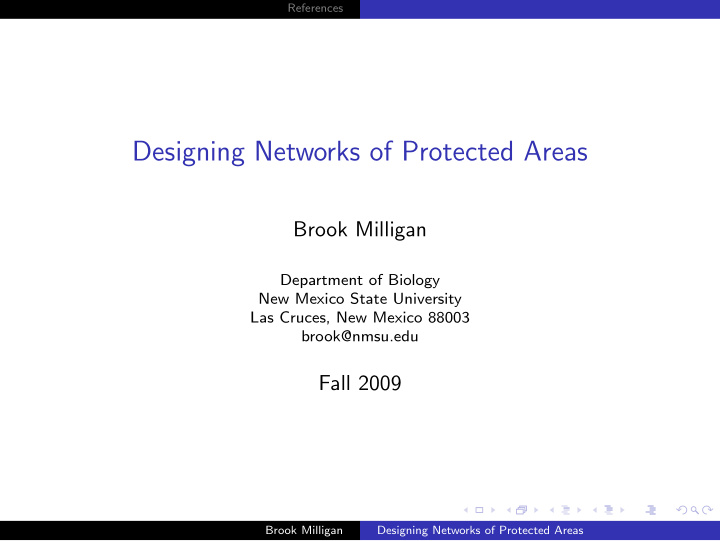



References Designing Networks of Protected Areas Brook Milligan Department of Biology New Mexico State University Las Cruces, New Mexico 88003 brook@nmsu.edu Fall 2009 Brook Milligan Designing Networks of Protected Areas
References Overall Design Principles Representation all conservation units must be represented in the reserve Resiliency reserves must be sufficiently large and well-protected to maintain all conservation units in healthy condition for the forseeable future Redundancy reserves must protect enough examples of each conservation unit to ensure long-term existence in the face of uncertainties Reality funds and political will must exist to acquire and manage reserves Brook Milligan Designing Networks of Protected Areas
References Issues of Reserve Design Focal questions Size: how large must nature reserves be to protect species? SLOSS: is a single large or several small reserves better? Individuals: how many individuals of a target species must be protected? Shape: what is the best shape for a reserve? Connectivity: when several reserves are created, should they be close together or far apart? isolated or connected by corridors? Brook Milligan Designing Networks of Protected Areas
References Issues of Reserve Design Brook Milligan Designing Networks of Protected Areas
References Relationship between Population Size and Area Brook Milligan Designing Networks of Protected Areas
References Relationship between Extinction and Area Brook Milligan Designing Networks of Protected Areas
References Importance of Networked Reserve Systems Effectively increases the total area = ⇒ reduces the extinction rate Corridors increase interchange = ⇒ reduces effect of small population size on genetic variation Encourages common management practices = ⇒ consistency across landscape Raises public profile of reserves = ⇒ perhaps greater chance of acceptance Brook Milligan Designing Networks of Protected Areas
References Conservation Networks: Case Studies Germany-Czech Republic Border Formerly the Iron Curtain divided wildlife habitat Berlin Wall removed on 9 November 1989 No ecological barrier to movement across border First trans-border preserve in European Union Red deer still do not cross border Wall Street Journal, 4 November 2009 Brook Milligan Designing Networks of Protected Areas
References Conservation Networks: Case Studies Klamath-Siskiyou Ecoregion Global center of biodiversity IUCN Area of Global Botanical Significance (1 of 7 in North America) Proposed as a World Heritage Site and UNESCO Biosphere Reserve Brook Milligan Designing Networks of Protected Areas
References Conservation Networks: Case Studies Klamath-Siskiyou Ecoregion Brook Milligan Designing Networks of Protected Areas
References Conservation Networks: Case Studies Corridors in Louisiana wetlands: Tensas River basin Former habitat of red wolf ( Canus rufus ) Florida panther ( Felis concolor coryi ) ivory-billed woodpecker ( Campephilus principalis ) Attempt to link remaining large patches with strategic protection of a small land area Examples addition of 400 ha of forest converts largest connected complex from 50,000 ha to 100,000 ha. addition of 600 ha links several 3,000–10,000 ha patches into 63,000 ha complex. Brook Milligan Designing Networks of Protected Areas
References Conservation Networks: Case Studies Community baboon sanctuary: Bermudian Landing, Belize Largely agricultural land Declining populations of black howler monkeys ( Alouatta pigra ) Community agreement to create forest borders along Belize River and at property/field boundaries Forest borders provide Result: increase in howler pathways linking forest monkey population and patches ecotourism Brook Milligan Designing Networks of Protected Areas
References Wildlands Project: Megalinkages Brook Milligan Designing Networks of Protected Areas
References Wildlands Project: Spine of the Continent Brook Milligan Designing Networks of Protected Areas
References Wildlands Project: New Mexico Highlands Brook Milligan Designing Networks of Protected Areas
References Wildlands Project: Detractors http://www.wildlandsprojectrevealed.org/ Brook Milligan Designing Networks of Protected Areas
References Liu, J., J. B. Dunning, Jr., and H. R. Pulliam. 1995. Potential effects of a forest management plan on Bachman’s Sparrows ( Aimophila aestivalis ): linking a spatially explicit model with GIS. Conservation Biology , 9:62–75. Lovejoy, T. E., R. O. Bierregaard, Jr., A. B. Rylands, J. R. Malcolm, C. E. Quintela, L. H. Harper, K. S. Brown, Jr., A. H. Powell, G. V. N. Powell, H. O. R. Schubart, and M. B. Hays. 1986. Edge and other effects of isolation on Amazon forest fragments. In Soul´ e, M., editor, Conservation Biology. The science of scarcity and diversity , chapter 12, pages 257–285. Sinauer, Sunderland, MA. Lynch, M. 1996. A quantitative-genetic perspective on conservation issues. In Avise, J. C. and J. L. Hamrick, editors, Conservation Genetics. Case histories from nature , chapter 15, pages 471–501. Chapman and Hall, New York, NY. Terborgh, J. and B. Winter. 1980. Some causes of extinction. In Soul´ e, M. E. and B. A. Wilcox, editors, Conservation Biology. Brook Milligan Designing Networks of Protected Areas
References An evolutionary-ecological perspective , chapter 7, pages 119–133. Sinauer, Sunderland, MA. Wilcove, D. S., C. H. McLellan, and A. P. Dobson. 1986. Habitat fragmentation in the temperate zone. In Soul´ e, M. E., editor, Conservation Biology. The science of scarcity and diversity , chapter 11, pages 237–256. Sinauer, Sunderland, MA. Brook Milligan Designing Networks of Protected Areas

Recommend
More recommend